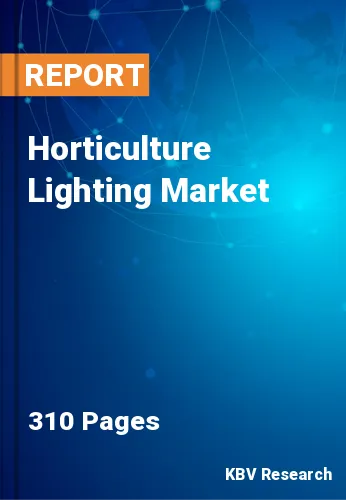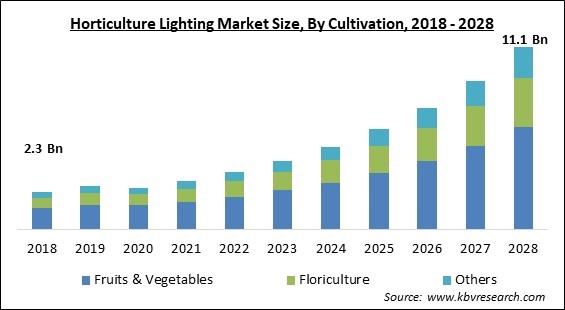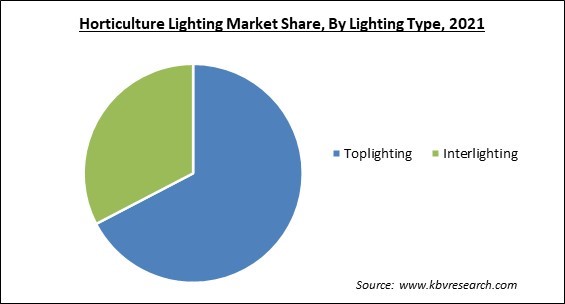
The Global Horticulture Lighting Market size is expected to reach $11.1 billion by 2028, rising at a market growth of 21.2% CAGR during the forecast period.
The effective spectral dispersion of light is critical for plant growth. The demand for horticultural lighting is projected to rise as more people become aware of the issue. One of the major factors driving up the demand for horticulture lighting is the need to maintain a controlled farm environment. With new lighting technologies, horticulture lights can assist maximize crop productivity while also saving energy. These characteristics of horticulture lights, as well as growing awareness among farmers, are expected to propel the market studied forward over the projection period. The use of horticultural lighting is projected to be aided by a rise in the number of food suppliers & farm start-ups.
With the growing popularity of indoor and vertical farming, LED lighting applications in the horticulture sector are becoming increasingly important. LEDs are widely employed in the production of a variety of crops, including herbs, tomatoes, greens, & cucumbers, among others, due to their tunable spectrum and illuminance. Farm8, a South Korean agriculture cultivator, has been using LED technology to aid in the growth of plants. When compared to the time it takes a plant to grow outside (50 days), a plant can be grown in roughly 35 days with this technique.
The world's rising population is driving up food demand, which is challenging to provide alone through conventional agriculture. But, advances in horticulture lighting have made it possible to boost crop yields in indoor agriculture. In the absence of presence or partial absence of natural light, horticulture light serves as the principal light source in indoor farming. GrowWise, a city farm facility concentrating on raising a range of crops like as leafy vegetables, strawberries, and other vegetables, was founded by companies like Signify (Philips Lighting). To boost crop productivity in its indoor farming facilities, the business plans to use LED horticulture lights.
Rapid population growth and urbanization, diminishing water supplies, and continuous climate change due to increased greenhouse gas emissions have all led to reduced arable land reserves per person. As agricultural land becomes more limited, governments face concerns about sustainability & feeding the world's rapidly growing population, which is anticipated to reach multiple billion by 2050. Because they depend on enhanced technology & automation to make the most of limited land and water, urban agriculture, greenhouse farming, and vertical farming are all instances of options for improving future food production. Within the limits of urban, weather high-rise structures, food production technology seeks to significantly boost productivity while minimizing environmental damage.

The outbreak and the spread of COVID-19 have disrupted the entire LED lighting supply chain, right from upstream chip manufacturers to packaging and lighting OEMs. The outbreak of COVID-19 in China, for example, prompted lockdown measures that included the closure of manufacturing facilities & warehouses, affecting global exports & shipments from a variety of businesses.
Lockdown measures implemented in various nations throughout the world in response to the COVID-19 pandemic resulted in a drop in local and international demand for consumer goods, particularly horticultural lighting. These firms' horticulture lighting products are acquired by a variety of stakeholders for diverse applications. COVID-19 had an impact not only on the operations of the numerous horticultural lighting producers but also on their suppliers & distributors.
The farm-to-table concept entails providing local produce to restaurants, cafeterias, fast food joints, and other places in the same neighbourhood. The demand for locally farmed food is expanding, and the number of customers interested in eating such meals is growing with each day. More people have joined in as the notion has risen in popularity, & there is no doubt that the complete awareness of consuming locally farmed food has improved in recent years. As a result, the farm-to-table idea is no longer exclusive to health-conscious or trend-conscious diners. The need for more locally sourced products may eventually spread across numerous markets in the hotel industry. In the case of farm-to-table restaurants, horticulture lighting ensures timely product availability.
These lights are also less expensive than other artificial lighting options. LEDs do not burn out like conventional light bulbs, although they do lose a little number of lumens with time. LEDs may last for more than 50,000 hours, whereas light bulbs only last around a year on average (depending on the type of application). The longer lifespan assures a high level of dependability. LEDs emit light more efficiently than previous lighting fixtures, producing far less heat. Heat is considered waste in conventional indoor farming and is eliminated by an air conditioner or fan. However, LEDs can reduce the energy usage involved with heat removal by not producing it in the first place.
With more people becoming aware of the advantages of horticulture lighting, the use of these devices is on the rise. Plants have been grown indoors using a variety of artificial lighting sources. Previously, HPS & electric ballasts were commonly employed as effective light sources in indoor farming. LEDs are popular nowadays because they eliminate the limitations of high-pressure sodium (HPS), fluorescent (FL), metal-halide, & electric ballast lights. The initial investment necessary to purchase high-quality LED lights is larger than that required to purchase traditional lighting technologies such as fluorescent & high-intensity discharge (HID) bulbs. This is because each LED light unit has arrays of LEDs that are specifically developed for horticulture use.

Based on Offering, the market is segmented into Hardware and Software & Services. The software & services segment garnered a significant revenue share in the horticulture lighting market in 2021. It is due to the increasing adoption of latest technologies and software. These kinds of software and service enable companies or farmers to control their lighting from anywhere and anytime. In addition, they are cost-effective and hence, are estimated to witness a surge in their demand.
Based on Technology, the market is segmented into LED, HID, Fluorescent, and Others. The LED segment acquired the highest revenue share in the horticulture lighting market in 2021. LED technology is gaining traction in the horticulture industry, due to part to NASA's ongoing plant-growth research using LED lighting. Because of its low energy consumption, cool operation, and flexibility to adjust the spectrum output to emit the particular wavelengths needed by plants, it has a lot of potential as a horticulture lighting fixture. Government attempts to promote the use of energy-efficient LEDs in horticulture to minimize energy consumption are projected to drive this segment's growth. LED lighting has become more efficient in converting electricity into light as a result of technological improvements, and this trend is projected to continue in horticulture. When compared to alternative horticulture lighting systems, LEDs are more energy-efficient and cost-effective.
Based on Application, the market is segmented into Greenhouses, Vertical Farms, Indoor Farms, and Others. The vertical farming segment garnered a significant revenue share in the horticulture lighting market in 2021. Vertical farms are being built in a variety of locations throughout the world, with North America, Europe, the Middle East, China, & Japan as the most active investors. Several well-known companies have begun to offer money to assist entrepreneurs to develop vertical farms.
Based on Cultivation, the market is segmented into Fruits & Vegetables, Floriculture, and Others. The others segment garnered a significant revenue share in the horticulture lighting market in 2021. Under this segment, falls the cultivation of cannabis. The legalization of cannabis production is gaining traction in several parts of the world, as policymakers try to make it a reality. This will undoubtedly benefit all types of cannabis farmers, but it is believed that manufacturers of LED grow lights would reap the most benefits. Cannabis is also regarded as a high-value crop by growers, & as a result, cannabis production is increasing at a quicker rate.
Based on Lighting Type, the market is segmented into Toplighting and Interlighting. The interlighting segment procured a substantial revenue share in the horticulture lighting market in 2021. Interlighting improves light reception in canopies that absorb less light in the middle or lower levels. Interlighting has higher light efficacy than top lighting, resulting in higher yields, and it primarily uses LED lights. The market for interlighting is likely to rise as the number of greenhouses for tomato & cucumber agriculture grows.
Based on Installation Type, the market is segmented into New Installations and Retrofit Installations. The new installation segment acquired the highest revenue share in the horticulture lighting market in 2021. The idea for a new installation Llghting is most commonly used to refer to artificial electric illumination installations, in which case the installation includes lighting devices with their light sources, starting and controlling apparatus, switchboards, supply mains, and other electrical equipment.
| Report Attribute | Details |
|---|---|
| Market size value in 2021 | USD 2.9 Billion |
| Market size forecast in 2028 | USD 11.1 Billion |
| Base Year | 2021 |
| Historical Period | 2018 to 2020 |
| Forecast Period | 2022 to 2028 |
| Revenue Growth Rate | CAGR of 21.2% from 2022 to 2028 |
| Number of Pages | 310 |
| Number of Tables | 609 |
| Report coverage | Market Trends, Revenue Estimation and Forecast, Segmentation Analysis, Regional and Country Breakdown, Companies Strategic Developments, Company Profiling |
| Segments covered | Offering, Technology, Cultivation, Lighting Type, Application, Installation Type, Region |
| Country scope | US, Canada, Mexico, Germany, UK, France, Russia, Spain, Italy, China, Japan, India, South Korea, Singapore, Malaysia, Brazil, Argentina, UAE, Saudi Arabia, South Africa, Nigeria |
| Growth Drivers |
|
| Restraints |
|
Based on Regions, the market is segmented into North America, Europe, Asia Pacific, and Latin America, Middle East & Africa. Europe acquired the largest revenue share in the horticulture lighting market in 2021. The fact that this region has few of the largest economies in the world, as well as blooming sectors that lead to higher capital investment capabilities, can be linked to the market's rise. Large regions of greenhouse horticulture can be found in countries like Spain, the Netherlands, Italy, and France. LED horticulture lights are steadily moving from being a supplemental lighting source to becoming the major light source for indoor farming in this region. Europe's population has grown quickly in recent years, and countries in the region are importing frozen fruits & vegetables from Africa & Asia. To supplement, the import of fruits and vegetables, some fruits and vegetables are planned to be grown domestically using horticulture lighting in indoor farms. Key Factors Impacting the Market
Free Valuable Insights: Global Horticulture Lighting Market size to reach USD 11.1 Billion by 2028
The market research report covers the analysis of key stake holders of the market. Key companies profiled in the report include Signify N.V., LumiGrow, Inc., Heliospectra AB, Iluminar Lighting LLC., Gavita International B.V., California LightWorks, Valoya Oy, Hortilux Schréder, and Eye Hortilux.
By Offering
By Technology
By Application
By Cultivation
By Lighting Type
By Installation Type
By Geography
Related Reports:
North America Horticulture Lighting Market Report 2022-2028
Europe Horticulture Lighting Market Report 2022-2028
Asia Pacific Horticulture Lighting Market Report 2022-2028
LAMEA Horticulture Lighting Market Report 2022-2028
The horticulture lighting market size is projected to reach USD 11.1 billion by 2028.The horticulture lighting market size is projected to reach USD 11.1 billion by 2028.
The farm-to-table concept is gaining traction are driving the market in coming years, however, LED horticulture lights have high setup & installation expenses growth of the market.
Signify N.V., LumiGrow, Inc., Heliospectra AB, Iluminar Lighting LLC., Gavita International B.V., California LightWorks, Valoya Oy, Hortilux Schréder, and Eye Hortilux.
The Hardware market dominated the Global Horticulture Lighting Market by Offering in 2021, thereby, achieving a market value of $7,287 million by 2028.
The Greenhouses segment is generating highest revenue in the Global Horticulture Lighting Market by Application in 2021, thereby, achieving a market value of $4,694.3 million by 2028.
The North America is the fastest growing region in the Global Horticulture Lighting Market by Region in 2021.
Our team of dedicated experts can provide you with attractive expansion opportunities for your business.
